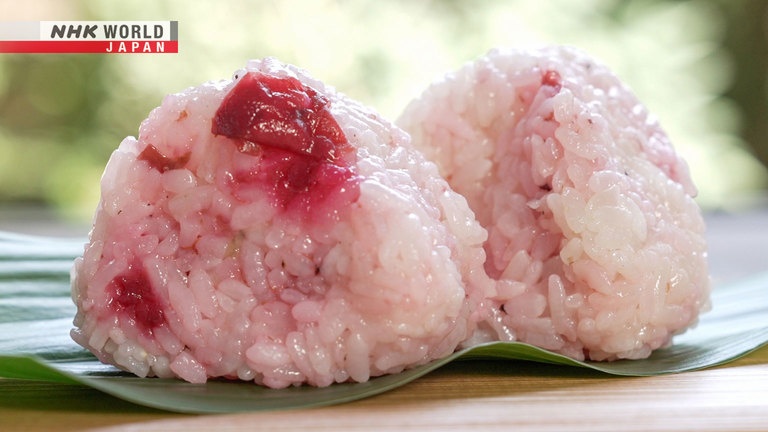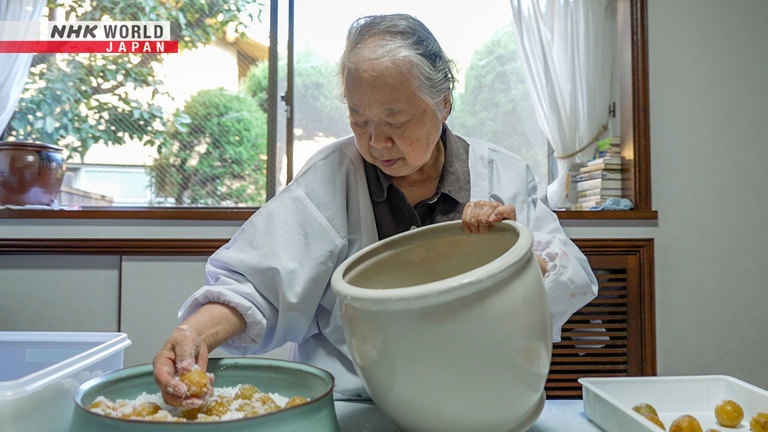Passing on Pickled Plums for Posterity
In a quiet Tokyo residential neighborhood is where you'll find the home of Norimatsu Sachiko. Open the door, and you're enveloped by the refreshing aroma of ume plums. Sachiko has dedicated much of her life to making umeboshi pickled plums, a traditional Japanese food. She even calls herself "Granny umeboshi." Her umeboshi are large, very sour and quite invigorating. Come visit her kitchen, and explore what has motivated her to keep making umeboshi for more than half a century.



Transcript
A sunny summer day.
Neatly lined up in crowded rows are umeboshi pickled plums.
Ume plums pickled in salt then dried,
umeboshi are a traditional Japanese preserved food with a unique taste.
Your face says it's sour!
A grimace-inducing sourness!
Their sour and salty flavor makes them an excellent companion to rice.
People all over Japan have loved this pickled food for more than a thousand years.
Umeboshi are the passion of this woman who's been making them for over half a century.
Few other foods silently support
people's lives like "umeboshi."
The "ume" god entrusted me
with this mission.
She wishes to pass on Japan's time-honored food culture to the next generation.
Let's look through the kitchen window, and follow her story.
A quiet residential area in Tokyo.
It's here that we find this house.
As we open the door, we're greeted… by a bunch of jars.
These are all processed ume plums.
This is the residence of Norimatsu Sachiko, who also sells her homemade ume products here.
She's now eighty-two years old.
Her passion for ume plums has led her to continue making umeboshi for more than fifty years.
Every year around June, she gets deliveries of fresh-harvested ume.
Isn't it lovely?
You don't see many like this.
It's like Miss Universe.
Sachiko uses a special kind of plum for her umeboshi.
Called "sugita-ume," they're a variety bigger than other types,
and are rich in citric acid, the source of their sourness.
Umeboshi's key ingredients are the plums themselves and salt.
First, Sachiko firmly rubs plenty of salt onto the ume.
I feel sorry. But I need to press
hard enough to leave scratches.
Thanks to the abundant citric acid and salt, umeboshi can be kept for a long time without preservatives.
She neatly lays the ume plums in a jar, and waits for two weeks.
The juice that comes out of the salted plums is called "white ume vinegar."
Next, Sachiko will turn the color of the ume to red.
For that, she uses aka-shiso, or red perilla.
She kneads the leaves with salt to remove their bitterness.
And when she pours ume vinegar...
See? The color turns red.
This reddish-purple liquid is called "red ume vinegar."
This will dye the plums.
Sachiko now pickles the perilla leaves along with the ume.
This one's big.
My little darling.
Such a nice aroma!
She pours white ume vinegar into the jar and lets it sit for two more weeks.
The power of perilla has turned the ume plums a bright red.
The final step will be the drying.
The umeboshi still have a long way to go.
Something prompted a major change in Sachiko's life.
Here are some "umeboshi."
Over fifty years ago, these umeboshi were found stored under the floor of a traditional Japanese restaurant where she worked.
I heard they were
over a hundred years old.
I was amazed.
I couldn't believe such a food existed.
These were made far more than a century ago, and are still perfectly good to eat.
Sachiko had found her calling to make umeboshi that would stand the test of time.
I saw it as my mission.
If I didn't continue,
I felt nothing else would pan out.
Since then, through trial and error, Sachiko has been striving to produce the ideal umeboshi.
Cicadas are chirping.
We can hear different kinds.
At the height of summer, umeboshi-making enters its final stage.
Sachiko is drying her ume plums in the sun in a corner of this shrine's backyard.
This step lasts for three days and nights of fine summer weather.
This is key to extending the shelf life of umeboshi.
Members of the family in charge of the shrine pitched in to give her a hand.
Massage the ume plums a little,
so both hard and soft ones dry evenly.
This one's hard, too.
They want to be massaged gently.
They soften the hard ones, and carefully reshape the soft ones.
They spread out the plums one by one with tender loving care.
At night on the third and final day...
Here comes the moment Sachiko loves the most about making umeboshi.
The temperature goes down at night,
turning the salt into dew.
The color is like ruby,
from the red of the "ume" and perilla.
I got to see the dew again this year.
It's always a breathtaking moment.
This one's small, but amazing.
It's full of energy.
Wow, look at this color!
It's going well.
They give it their all to the very end.
It moves me, almost like a drama.
That's why I can get up late at night.
Otherwise, I'd rather be sleeping,
to be honest.
The sun comes up, and when the ume plums are dry, their three-day sunbathing session is over.
They go back in their jar to rest for a while, then the prime quality umeboshi are ready.
Sachiko hopes that people will be eating her umeboshi even a century from now.
Sachiko is preparing some dishes using her umeboshi.
First, she'll make onigiri rice balls.
On steamed rice, she pours some red ume vinegar.
She also mixed in a little bit of it when cooking the rice.
I tear off some bits of "umeboshi"
and add them to the rice.
Some perilla, too.
The rice is turning red.
Red ume vinegar also has a sanitizing effect.
Citric acid kills germs.
So, it's a better seasoning than salt.
Ume vinegar isn't just salty.
It also adds umami flavor.
What's more, she uses it to make a salad dressing as well.
I want to use ume vinegar
as much as possible.
She mixes plenty of red ume vinegar with the other ingredients.
To enrich the flavor, Sachiko adds ume extract - made by boiling down ume plums.
And the dressing is ready.
Next, she slices onions and soaks them in the dressing.
Finally, she combines them with tomatoes, and lets them sit for about three hours in the refrigerator.
And voilà: Sachiko's special ume onigiri rice balls with marinated onions and tomatoes.
With the mouthwatering aroma of red ume vinegar, they're perfect dishes for summer.
Here's a grove of sugita-ume trees, the variety that Sachiko uses for her umeboshi.
Sugita-ume plums are rich in citric acid, and so are essential for making umeboshi that stay good for generations.
But Japanese people these days prefer umeboshi with a lighter sourness.
And so, many sugita-ume trees are being cut down.
I want to preserve these plum trees.
I cherish them like my own life.
So, I've decided
to increase their numbers.
Sachiko's wish struck a chord with Ono Hiroki - who's been helping her make umeboshi for four years.
The two have launched an effort to plant more sugita-ume trees.
They send seedlings of sugita-ume to like-minded people willing to grow and take care of the trees.
In two years, the number of planted seedlings has topped one hundred.
They also had a tree planted at the shrine Sachiko uses to sun dry her plums.
- It's looking good.
- Yes.
It's good soil, like a carpet.
It takes six to eight years for sugita-ume seedlings to bear their large plums.
Increasing the number of these trees one by one is truly a labor of love.
Whether it's the lifetime of a person,
an "ume" tree, or "umeboshi"...
you can't just magically whip it up.
I want more people to preserve and pass on
such treasured things and traditions.
Ever thankful for umeboshi, Sachiko will continue to make them a part of her life.
People used to put an "umeboshi" here
if their head hurt. It worked.
The grandma next door often did it.
I wondered if I'd become
a Granny "Umeboshi" like her.
Time flies!
It really does!